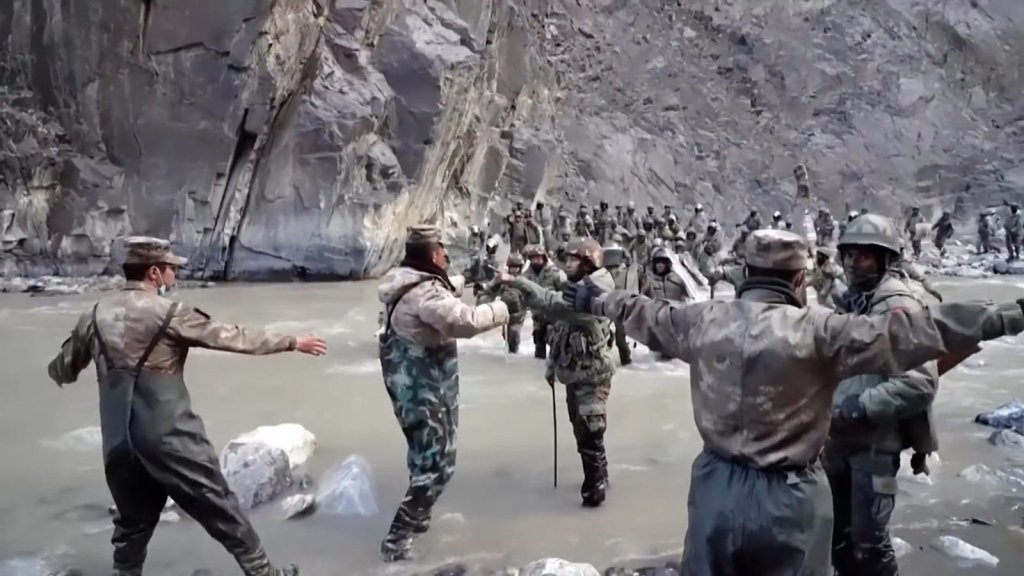Improved relations and economic interdependence will not constrain China’s expansionism

BY BRAHMA CHELLANEY, The Japan Times
China and India have been locked in a tense conflict along their Himalayan border since April 2020, when Chinese troops stealthily encroached upon some key borderlands in the northernmost Indian territory of Ladakh. More than three years later, the standoff between rival forces has solidified, with China continuing to frenetically erect new warfare infrastructure along the long frontier.
Even then, Chinese President Xi Jinping is expected to visit New Delhi next month for the Group of 20 summit, which is likely to be attended by other world leaders, from U.S. President Joe Biden and French President Emmanuel Macron to Prime Minister Fumio Kishida. Russian President Vladimir Putin’s appearance is uncertain given that the war in Ukraine appears to be at a pivotal stage.
The Sept. 9-10 summit raises the possibility that Xi’s trip could propel efforts for a deal to help defuse what has become an increasingly dangerous military confrontation between the nuclear-armed demographic titans. Both sides have forward deployed more and more lethal weapons.
Meanwhile, border clashes have intermittently occurred since May 2020, even as corps commanders from the two militaries have met 18 times over three years to negotiate a pullback of forces. Through these lengthy negotiations, India has managed only to get China to convert its smaller encroachments into buffer zones — largely on Beijing’s terms, with Indian forces retreating further back into their own territory.
Today, with more than 100,000 rival troops backed by reserves locked in the standoff at multiple sites from the western to the eastern Himalayas, the military crisis can be eased only if both sides agree to sequentially disengage, de-escalate and de-induct forces from front-line positions through verifiable methods.
However, there seems little prospect of a return to the status quo ante along the disputed frontier. China has not only changed the territorial status quo in the western sector but also remains engaged in a frenzied construction of new military infrastructure along the entire border, as if it were preparing for war. The new infrastructure extends from helipads and radar sites to cold-weather troop shelters and ammunition depots.
Even if a deal of some sorts was reached to ease military tensions, the largest Himalayan buildup of rival forces in history, coupled with the expanding Chinese warfare infrastructure, promises to lastingly turn what was once a lightly patrolled frontier into a perennially hot border.
More broadly, the Himalayan conflict also holds lessons for Japan, whose control of the Senkaku Islands, called the Diaoyu in China, has come under increasing challenge from China. The record-long Chinese intrusion in April into Japanese territorial waters near the islets highlighted this challenge.
In fact, China is pursuing its revisionism against Japan in ways that mirror its strategy of attrition, friction and containment against India. Incremental advances by stealth below the threshold of war through a “salami-slicing” approach have become integral to China’s expansionism.
Sinicizing the names of the places it covets is also part of China’s strategy to buttress its sovereignty claims. But China’s various territorial claims in Asia are based not on international law but on alleged history.
Like Japan, India has been overly on the defensive. Consequently, the daunting challenge India faces today is to regain lost territory in the same way China took it — without resort to open combat.
For Japan, the fundamental message from Chinese expansionism in the Himalayas is that China can disturb the status quo at any time of its choosing, even if it means violating binding bilateral agreements and international norms. China’s military actions against India openly breach four separate border management agreements the two sides signed between 1993 and 2013, including forswearing any attempt to unilaterally change the territorial status quo.
As Japan’s own experience in dealing with Chinese intrusions underscores, stealth, deception and surprise are central to China’s strategy.
In fact, improvements in bilateral relations do not deter Beijing from springing a nasty surprise on the other side. The Chinese encroachments on the Indian borderlands occurred just six months after Xi declared during an India visit that, “China-India relations have entered a new phase of sound and stable development.”
Simply put, China’s aggressive actions bear no relation to the state of ties with the country it targets. Seeking better relations with Beijing, far from helping to improve Chinese behavior, can even backfire, as Indian Prime Minister Narendra Modi has bitterly discovered. Seeking to befriend China, Modi met with Xi 18 times over five years before the Chinese encroachments occurred.
Another lesson is that booming bilateral trade and economic interdependence also do not constrain China’s behavior. If anything, expanding economic ties only constrict the other side’s strategic leeway for fear of losing access to the Chinese market.
Yet another lesson for Japan, as for India, is that being constantly on the defensive only emboldens China to needle the targeted country or infringe its sovereignty. Coming out of a reactive and defensive mode is vital to checkmate China’s expansionist designs.
Having normalized its intrusions into Japanese territorial waters and airspace, China is working to progressively alter the status quo in the East China Sea in its favor. It draws strength from its success in redrawing the geopolitical map of the South China Sea without firing a single shot or incurring any international costs.
If Japan is not to find itself increasingly at the receiving end of China’s muscular revisionism, it must formulate a concrete counterstrategy.
Brahma Chellaney, a longtime contributor to The Japan Times, is a geostrategist and author of nine books, including “Water: Asia’s New Battleground.”

You must be logged in to post a comment.